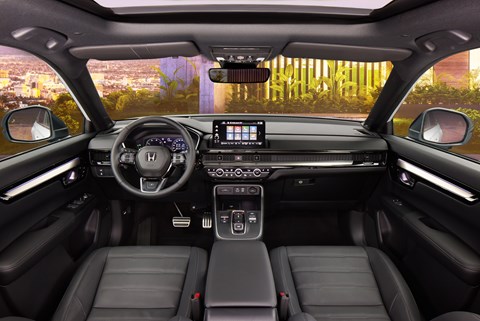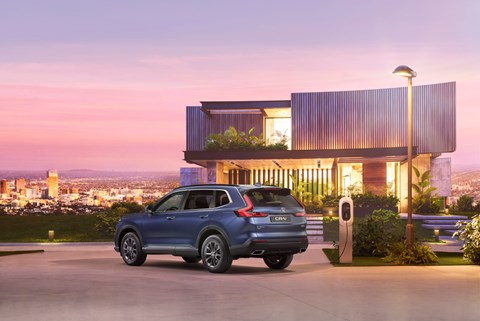► Honda replaces its family SUV
► On sale before the end of 2023
► Hybrid and PHEV powertrains
Honda has unveiled its replacement for the CR-V. The Japanese brand’s next family SUV will go on sale in Europe later this year, offering renewed competition for the likes of the Skoda Kodiaq, Kia Sportage, Peugeot 3008 and Toyota RAV4.
And it seems Honda is very keen to chase down the RAV4 with this CR-V as, unlike the outgoing model, it’ll be available with a choice of full hybrid and plug-in hybrid powertrains, the latter of which will be capable of covering around 50 miles on electric power alone.
Honda hasn’t yet confirmed the output of the CR-V PHEV’s powertrain or the size of its battery pack, although the brand has confirmed the system will be based around a 2.0-litre four-cylinder petrol engine. It also claims the car’s battery can charged from 0–100% in 2.5 hours, although it hasn’t specified at what speed.
To be competitive with the Toyota RAV4, the CR-V will need an output of around 300bhp and a 0–62mph time of six seconds. Like its biggest rival, we expect the Honda will have its electric motor mounted on the rear axle, giving it four-wheel drive.
The full hybrid CR-V is far more familiar. It uses the same 2.0-litre e:HEV powertrain fitted to the latest Civic. Again, Honda hasn’t confirmed how much power the unit will produce in the CR-V, but we reckon its output will be identical at 181bhp and 258lb/ft of torque.
Tell us about the interior
Certainly. The dashboard has been transferred almost wholesale from the Civic, which is no bad thing because we’re huge fans of that car’s crystal clear 9.0-inch infotainment system, sneaky hidden air vents and simple rotary climate controls.

We travelled to Frankfurt to see the new CR-V in the flesh and we’re happy to report that it shares the Civic’s stellar build quality. The SUV’s cabin is robust enough to soak up the punishment of family life, but it still manages to feel more upmarket than any of its mainstream rivals from Volkswagen, Skoda and Kia.
Honda has also pressured its engineers to make the CR-V easier to live with, placing particular emphasis on visibility. The outgoing model had narrow side windows and a letterbox-shaped rear screen shrouded by enormous rear headrests, which made it very difficult to judge where the car’s corners were.
The last CR-V’s visibility issues weren’t helped by the fact that it trailed its rivals on the technology front. It was only available with parking sensors and a rear-view camera, while key rivals like the RAV4 and Sportage can be specified with 360-degree parking cameras.
Honda reckons it has rectified all these problems for the new car. The new car’s glasshouse is wider than before, while top spec versions of the car can be specified with Honda Sensing for the first time, both on the CR-V and on a European Honda vehicle. This 360-degree safety suite comprises a range of cameras dotted around the car which Honda says will remove the driver’s blind spots and help avoid accidents by cutting down their cognitive load.
Will the new Honda CR-V be practical?
Big time. Honda has made the new CR-V larger in every dimension – and it says this supersizing has liberated a load of space inside for passengers. The most critical dimensional change is the increased wheelbase. It’s 40mm longer than before which has unlocked an extra 14mm of legroom in the back. As an added benefit, it should also make the car more comfortable on the motorway.
The rear bench has been fettled, too. There are now eight levels of adjustment for the rear seat back ranging from ‘prison bedframe’ to ‘Mediterranean sun lounger,’ allowing the driver to prioritise either maximum luggage space or passenger comfort.
Honda also tells us the new CR-V will have more luggage space than the old one, although it hasn’t yet given us a transparent boot space figure. All the firm has said is that the new car will have 118% of the luggage capacity of the outgoing one. The previous CR-V had a 497-litre boot and, if you multiply that figure by 118%, you arrive at 586 litres. That’s six litres more than you get in a RAV4.
Tom Gardner, Senior Vice President at Honda Motor Europe, said: ‘The all-new CR-V builds upon everything the iconic model stands for – progressive design, a premium cabin, class-leading levels of safety, practicality and comfort, and efficient and responsive performance. This latest iteration is the ultimate SUV package, offering a unique, dynamic and premium product that perfectly suits the current demands of the European market.’
How much will new Honda CR-V cost?

Honda hasn’t yet announced UK prices and specs for the CR-V. The SUV is still a few months away from hitting UK shores, so the company will play it cards close to its chest until the first shipment of cars leaves its production facilities in Wuhan.
Given how much standard kit it’ll come with (we’re talking panoramic sunroof, leather seats, loads of safety equipment, a 9.0-inch infotainment system and a 10.25-inch digital gauge cluster), we can’t see Honda trying to compete with the RAV4 on price. To give you a frame of reference, the entry-level RAV4 Hybrid is priced at around £36,000, while the cheapest PHEV costs roughly £44,000.
We reckon the cheapest CR-V e:HEV will cost at least £42,000, while the PHEV model could set you pack upwards of £50,000. That’s a considerable chunk of change – but if it’s as good as the Civic, we reckon Honda will be able to justify the steep price-tag.